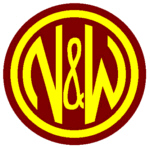
Track Plans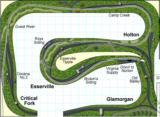 N&W Track Plans N&W Track Plans
|
Photos | Models |
History
The Norfolk and Western, first named so in 1881, was formed from more than 200 acquisitions and mergers beginning in 1838, eventually spanning from the tidewaters of Virginia to Omaha, Nebraska and reaching as far north as Buffalo, New York. Even though it entered the midwest in force in the 1960s, the N&W was always known best for hauling coal out of the Appalachians.
Prior to 1964, the relatively short mainline of the N&W went from Norfolk, Virginia (home of its famous coal piers) to Columbus, Ohio with other major arteries stretching to Cincinnati, Ohio; Hagerstown, Maryland, North Carolina and southwestern Virginia. In the middle of these lines was a core of twisted branch lines spreading from the mainline into the coal fields of West Virginia, Virginia and Kentucky. While its strategic route yielded a fair amount of bridge traffic between the eastern coast and the Midwest, coal was king, and it competed directly with its neighbors in these parts, the Chesapeake and Ohio and Virginian, to bring coal to Virginia’s ports as well as sending it westward. The coal fields served by the N&W were known for their high quality coal, especially for making steel. The N&W was also known for its large and heavy-hauling steam locomotives (though it also operated a section of the eastern grade to Elkhorn Tunnel, West Virginia using electrics from 1925-1950). It continued to invest in new steam engines long after most Class 1 railroads had lost interest in theirs, and it didn’t fully convert to diesels until 1960.
In 1959, the N&W acquired its closest neighbor, the Virginian, giving it access to more coal and a second mainline to the tidewater area as well as a connection with the New York Central at Deepwater, WV. Though electrics were central to the Viginian’s operations in West Virginia, the N&W removed them from service by the end 1962 as it had its own in 1950.
In 1964, the N&W acquired four midwestern railroads: the New York, Chicago & Saint Louis (Nickel Plate Road), the Wabash, the Pittsburgh & West Virginia and the Akron, Canton & Youngstown. These roads dramatically increased the N&W’s influence in the midwest and broadened its scope well beyond the coal fields of Appalachia. However, the N&W’s coal fields did expand with the acquisition of the NKP’s former Wheeling & Lake Erie lines in southeastern Ohio. The N&W also owned the Erie Lackwanna and Delaware & Hudson beginning in the late ’60s, but these were never merged into the N&W and later became part of Conrail and Guilford, respectively. In 1981, the N&W also acquired the small Illinois Terminal Railroad.
Finally, in 1982, the N&W merged with the Southern Railway to form Norfolk Southern. The merger of these two profitable roads enabled them to stay competitive with the large mergers happening all around them resulting in CSX.
Coal Lines and Operations
N&W coal was serviced primarily by three divisions: the Pocahontas Division, the Scioto Division and later the Pittsburgh Division (the Radford Division south of the Pocahontas Division was a source of anthracite coal early on but became primarily a source of other ore). The Pocahontas Division, by far, originated the most coal.
The Pocahontas Division stretched from Bluefield, VA in the east to Williamson, WV in the west (about 100 miles). While the mainline was relatively short for a Division, it made up for it with branchlines and secondary mains stretching all throughout the hills and hollers of southern West Virginia, southwestern Virginia and eastern Kentucky. The Virginian lines west of Princeton initially ran as a separate division after the 1959 merger but soon also became part of the Pocahontas. The lines of the Pocahontas Division resemble a twisted fork with the mainline from Williamson forming the handle and branches forming the remaining tines–this “fork” was the Pocahontas District. A secondary mainline known as the Clinch Valley District ran from Bluefield west to Norton, VA and a connection with the L&N and Interstate RR (later Southern). Finally, the ex-Virginian lines west of Princeton including the connection with the C&O and NYC at Deepwater, WV made up the Princeton-Deepwater District of the Pocahontas.
Pocahontas District. The central feature of the Pocahontas District was the double-track mainline from Bluefield to Williamson. The most notable feature along the main was the 1.2 mile long Elkhorn Tunnel which sat at the summit of the line. This tunnel replaced a steeper section of electrified territory to a shorter tunnel that was retired around 1950. Another notable feature of the line was the Bluestone Branch, just east of Elkhorn Tunnel. The Bluestone Branch left the main heading south following the Bluestone River. The branch then turned sharply back north and crossed under the mainline just west of a tunnel. All along the mainline were branches and tipples of all shapes and sizes. Bluefield and Williamson both served as large classification yards on either end of the mainline but there were smaller yards at Flat Top, Vivian, Farm, and Devon, many of which served as bases for the dozens of mine runs required to work the tipples and branches.
The most significant branches were the Dry Fork Branch and the Gilbert Branch. The Dry Fork Branch ran from Iager, WV to Cedar Bluff, VA where it connected with the Clinch Valley District. Dry Fork mine runs worked primarily out of Auville Yard near Iager. The Gilbert Branch spun off the mainline at Wharncliffe, WV, and though it was short, it provided a connection with the Virginian and C&O at Gilbert, WV. After the merger with the Virginian, this branch provided a second route to move coal east. The westernmost “tine” in the Pocahontas fork was created much later. The Buchannan Branch was another long branch that extended south from the main at Devon, WV (near Williamson) to Page, VA (not to be confused with Page, WV on the Virginian) with small yards at Weller and Dismal, VA.
Clinch Valley District. The Clinch Valley District mainline was actually the original N&W mainline west of Bluefield, built to form a strategic connection with the L&N. In 1891, the connection was made at Prince’s Flats, VA which was subsequently renamed Norton. Connections with other roads would soon follow including the Interstate Railroad at Norton and the Clinchfield at St. Paul, VA. The line from St. Paul to Norton is one of the most scenic on the N&W with several tall steel trestles and tight tunnels cutting across the mountains. In addition to important connections, the Clinch Valley District was a large producer of coal. Coal tipples and branches dotted the mainline, but the most significant branch was the Dumps Creek Branch north of the small yard at Carbo, VA. The “Moss” tipples and preparation plants were split between the Dumps Creek Branch and the nearby Clinchfield, so there was a fair amount of interchange between the two roads at Boody Yard near St. Paul, VA.
When coal traffic picked up in the ’60s, the N&W built the Wyatt Cut-Off from Whitewood, VA on the Jewell Valley Branch (near Dismal, VA) to Richlands, VA on the Clinch Valley District. This gave the N&W a shorter route for coal moving south via its connections on the end of the Clinch Valley line. In 1965, the Southern took over Interstate operations giving the N&W even more options to meet the increasing demand for coal in the South. Unfortunately, the Southern’s acquisition of the Interstate caused additional complications as well. For decades, the L&N had relied on the Interstate to move coal from Dorchester Jct., near Norton, to its partner, the Clinchfield, at Miller Yard, just west of St. Paul, VA. By the early ’70s, the L&N was fed up with the Southern’s inability to move its coal to the Clinchfield in a timely manner, and in 1973, it entered into trackage rights agreements with the N&W to move its own coal trains from Norton to St. Paul. A new track was built to form a wye on the west end of St. Paul so the L&N could drop off trains in the Clinchfield’s small Cassel Yard south of St. Paul. This arrangement lasted until 1986 when the NS and CSX entered into a mutually beneficial trackage rights agreement which allowed NS trains to move south from St. Paul via the former Clinchfield and CSX trains to move south from Big Stone Gap (west of Norton) via the former Southern.
Princeton-Deepwater District. The Princeton-Deepwater District, consisting of the former Virginian lines from Princeton, VA to Deepwater, WV, was a latecomer to the Pocahontas Division. After the 1959 merger, the district was originally part of the N&W’s New River District, but it eventually found its way to the Pocahontas Division with which it had so much in common. The mainline from Elmore to Roanoke, VA was the territory of the Virginian’s electrics which were used to haul coal up the 2% grade from Elmore to Clarks Gap, but the N&W abandoned the electrics in 1962. While the line to Deepwater and its connection with the C&O and NYC (later PC and Conrail) was officially the Virginian’s mainline west of Mullens, the line from Elmore, WV (Mullens) to Gilbert was the most important line. In 1967, the U.S. Army Corps of Engineers began work on a dam on the Guyandot River forcing a significant realignment of the N&W’s line from Elmore to Gilmore which opened in 1974.
As in Virginian times, Elmore Yard served as home to most of the district’s mine runs. Smaller yards at Gilbert, Pemberton and Page (near Deepwater) also played a role in mine run operations. The district served many branches including the long Glen Rogers branch west of Mullens and the Winding Gulf Branch which tangled with the C&O for most of its length. Like the Virginian, the N&W jointly owned a few of the branches with the C&O including the Stone Coal Branch (between Mullens and Pemberton) and the White Oak Railway.
Scioto Division
The Scioto Division stretched 210 miles from Williamson, WV to Columbus, OH, but it was the Kenova District at the east end of the division that brought in the coal. Like the Pocahontas District to the east, tipples dotted both the double-track mainline and branches of various lengths. The most significant branches were the Lenore Branch, which branched into the coalfields from Nagatuck, WV, and the Wayne Branch which ran from Kenova. The Wayne Branch once connected to the Lenore Branch but was cut back to East Lynn, WV. Most of the tipples were close to Williamson, home to the mine runs, and as the line approached Kenova and the Ohio River, coal gave way to other industries. Kenova was home to a connection with the B&O and C&O railroads, but most connections were further west in Ohio at Portsmouth, Cincinnati and Columbus and included the DT&I (Ironton, OH), PRR, NYC (later PC and Conrail) and multiple connections with the B&O and C&O. The Scioto Division was once the end-of-the-line, but after the NKP, ACY, P&WV and Wabash merger in 1964, the N&W bought a portion of the PRR from Columbus to Bellvue, OH to connect with its new lines, thus making the Scioto Division a through line and an even bigger avenue for westbound coal.
Pittsburgh Division
 The final major coal-producing division on the N&W was the Pittsburgh Division. The Pittsburgh Division included the NKP’s ex-Wheeling & Lake Erie (W&LE) lines in southeastern Ohio and the Pittsburgh & West Virginia (P&WV). The W&LE lines ran to Zanesville, OH, a long-time coal producing town, but most of the coal was gone before the N&W took over. However, the W&LE south/east of Pittsburgh Jct., OH was littered with coal mines and tipples. The major yard on the W&LE District was Brewster, OH, but most of the mine runs worked out of the small yard at Adena, OH. The W&LE lines connected with the B&O, PRR, NYC and later the Penn Central and Conrail. The P&WV mainline from Pittsburgh Jct. to Connelsville, PA added connections with the Pittsburgh & Lake Erie (P&LE) and the Western Maryland in addition to more connections with the B&O and PRR. For more information, see the Nickel Plate page.
The final major coal-producing division on the N&W was the Pittsburgh Division. The Pittsburgh Division included the NKP’s ex-Wheeling & Lake Erie (W&LE) lines in southeastern Ohio and the Pittsburgh & West Virginia (P&WV). The W&LE lines ran to Zanesville, OH, a long-time coal producing town, but most of the coal was gone before the N&W took over. However, the W&LE south/east of Pittsburgh Jct., OH was littered with coal mines and tipples. The major yard on the W&LE District was Brewster, OH, but most of the mine runs worked out of the small yard at Adena, OH. The W&LE lines connected with the B&O, PRR, NYC and later the Penn Central and Conrail. The P&WV mainline from Pittsburgh Jct. to Connelsville, PA added connections with the Pittsburgh & Lake Erie (P&LE) and the Western Maryland in addition to more connections with the B&O and PRR. For more information, see the Nickel Plate page.
Articles:
- Pusher Operations on the N&W’s Clinch Valley by Harry Dolan
- N&W Train Symbols by Harry Dolan
- Norton Yard Brakes and Tight Tunnels by Harry Dolan
- Planning Your Model Hopper Fleet by Dan Bourque
Related Products:
Sources:
- Flanary, Ron. L&N in the Appalachians. Old Line Graphics.
- Norfolk & Western Historical Society (nwhs.org)
- N&W Timetable – Scioto Division 1965
- N&W Track Chart – Pocahontas Division 1984
- N&W Track Chart – Scioto Division 1987
- Reisweber, Kurt. Virginian Rails. Old Line Graphics.
For related information, see the Virginian, NKP and NS pages




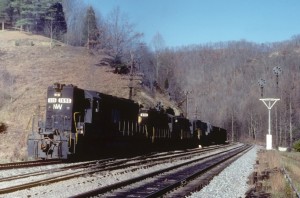
 N&W Photos Page
N&W Photos Page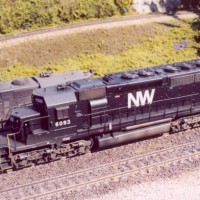 N&W Models Page
N&W Models Page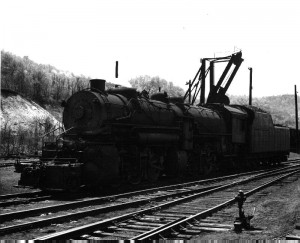

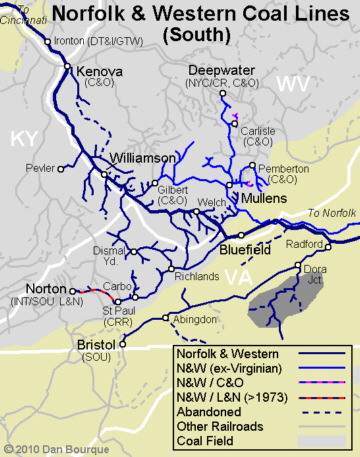
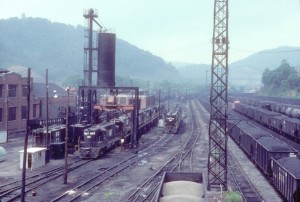
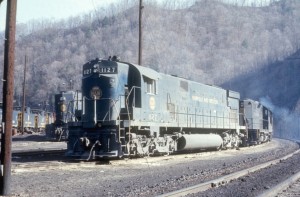
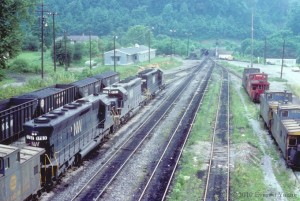
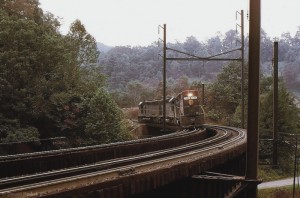
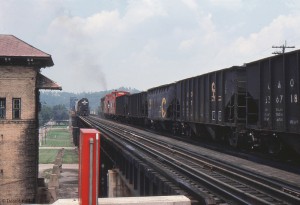
Looking for info about naming of bridges across the Bluestone. For example, would the 1st crossing be the one nearest Bluefield or the one closest to Bluestone?